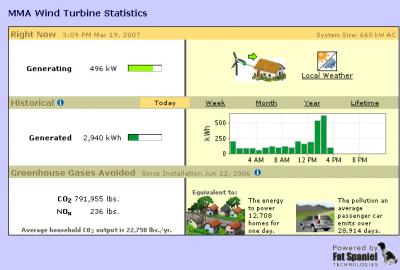Its been a while since I checked in on the Mass Maritime Acadmey wind turbine. I was over in that neighborhood oday and I am happy to report that it’s still going strong, here is a small video that I took today. Man was it windy.
They even have a cool feature on their website that lets you see the current output of the turbine. Today it was pumping out a lot of juice.

to save water .here r some methodsWater-saving techgolony for the home includes: Low-flow shower heads sometimes called energy-efficient shower heads as they also use less energy, Low-flush toilets and composting toilets. These have a dramatic impact in the developed world, as conventional Western toilets use large volumes of water. Dual flush toilets created by Caroma includes two buttons or handles to flush different levels of water. Dual flush toilets use up to 67% less water than conventional toilets. Saline water (sea water) or rain water can be used for flushing toilets. Faucet aerators, which break water flow into fine droplets to maintain wetting effectiveness while using less water. An additional benefit is that they reduce splashing while washing hands and dishes. Wastewater reuse or recycling systems, allowing: Reuse of graywater for flushing toilets or watering gardens Recycling of wastewater through purification at a water treatment plant. See also Wastewater ReuseRainwater harvesting High-efficiency clothes washers Weather-based irrigation controllers Garden hose nozzles that shut off water when it is not being used, instead of letting a hose run. using low flow taps in wash basins Automatic faucet is a water conservation faucet that eliminates water waste at the faucet. It automates the use of faucets without the use of hands. A valve which reduces water, gas, time, money and CO2 known as a CombisaveWater can also be conserved by landscaping with native plants and by changing behavior, such as shortening showers and not running the faucet while brushing teeth.